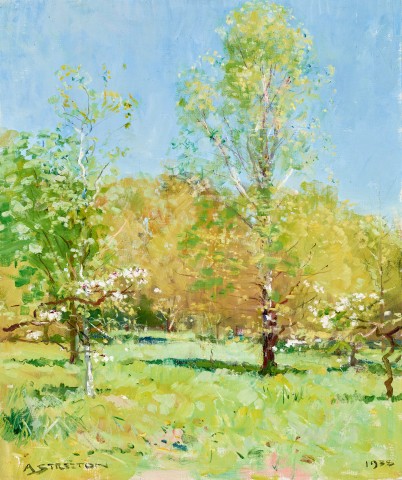SUNLIGHT AFTER RAIN, 1938
ARTHUR STREETON
oil on canvas
76.5 x 64.0 cm
signed lower left: A STREETON
dated lower right: 1938
bears inscription on stretcher verso: 6
Estate of Mrs. M. Levinson, Adelaide
Theodore Bruce, Adelaide, 11 November 1962, lot 92 (as ‘In the Park’)
Private collection, Adelaide
Thence by descent
Private collection, Adelaide
Arthur Streeton’s Exhibition: Form and Colour, Athenaeum Gallery, Melbourne, August 1938, cat. 6
Three varied exhibitions of Fine Australian Traditional Art, Bugle Galleries, Adelaide, 24 February – 30 March 1976 (as ‘In the Park’)
‘Paintings by Sir A. Streeton’, The Age, Melbourne, 2 August 1938, p. 6
‘S.A. Auction’, The Advertiser, Sydney, 15 November 1962 (as ‘In the Park’)
Even as a young man in his twenties, Arthur Streeton longed for a garden of his own, writing to Tom Roberts in 1892 about the home of a patron, ‘Peach trees in blushing bloom …scarlet poppies bending to the rich grass, & bright sweet nasturtiums & mignonette & violets, ay’ and roses, all blooming around a pretty house… Yes, I must have a pastoral treasury like this some day’.1
The first steps towards making this desire a reality took place during the 1920s, by which time Streeton was widely celebrated as one of Australia’s finest painters. In 1921, he purchased five acres of land at Olinda in the Dandenong Ranges east of Melbourne, naming it ‘Longacres’. Following the sale of Golden Summer, Eaglemont, 1889 (National Gallery of Australia) for the extraordinary sum of 1000 guineas, he built a house there several years later and enthusiastically began to develop a garden against the backdrop of established native blackwoods and gum trees. In 1927, Streeton bought a house on the corner of Grange Road and Douglas Street in Toorak, later purchasing the neighbouring property in order to extend the garden. He typically spent summers at Olinda, as well as making regular visits during the year, a pattern which he maintained throughout the following decade until moving there permanently in 1939.
Writing to Julian Ashton in July 1934, Streeton joked, ‘I am beginning to find that painting nowadays is beginning to interfere seriously with my gardening operations.’2 Indeed, the strength of his horticultural passion was made very clear in an article he penned earlier that year for the Melbourne Argus: ‘Gardening, once it attains a firm hold upon a man, enslaves him just as does alcohol or a pernicious drug; but the after-effects are entirely different. Doing one’s own gardening, like painting pictures, has its own reward – the secret pleasures of doing it… It is one of the advantages of a civilised state to labour from morning till night in one’s half-acre garden with the freedom to do things in one’s own way.’3
It is not surprising then, that views of domesticated landscapes – including his own gardens – feature in Streeton’s oeuvre, and many of the still life paintings produced later in his career depict flowers which he had tended and grown. Sunlight After Rain, 1938 cannot be confidently identified as a view of ‘Longacres’, however in its depiction of two tall trees enclosed in an intimate space with a dense band of trees beyond, we see the artist’s familiarity with his subject, as well as his sensual response to its natural beauty. The image is infused with light, the ubiquitous ‘blue and gold’ so well-known from his earlier landscapes combined with the depiction of the varied textures and colours of foliage, at which he was so adept. Streeton received major accolades during the 1930s: he was the subject of a retrospective at the National Art Gallery of New South Wales in 1931, and received a knighthood in 1937. These career highlights were counterbalanced in 1938 with the death of Nora, his wife of thirty years. Looking for meaning beyond the literal, it is tempting to interpret this painting as an image of quiet optimism, acknowledging his sadness, but looking forward to the possibilities of the future.
1. Streeton to Tom Roberts, Melbourne, 29 June 1892 quoted in Smith, G., and Streeton, O., Arthur Streeton: The Passionate Gardener, Mornington Peninsula Regional Gallery, Mornington, 2001, p. 7
2. Streeton to Julian Ashton, Melbourne, 4 July 1934 quoted in Smith and Streeton, op. cit., p. 12
3. Streeton, A., ‘On Gardening – A Reverie’, Argus, Melbourne, 6 January 1934, p. 4
KIRSTY GRANT
